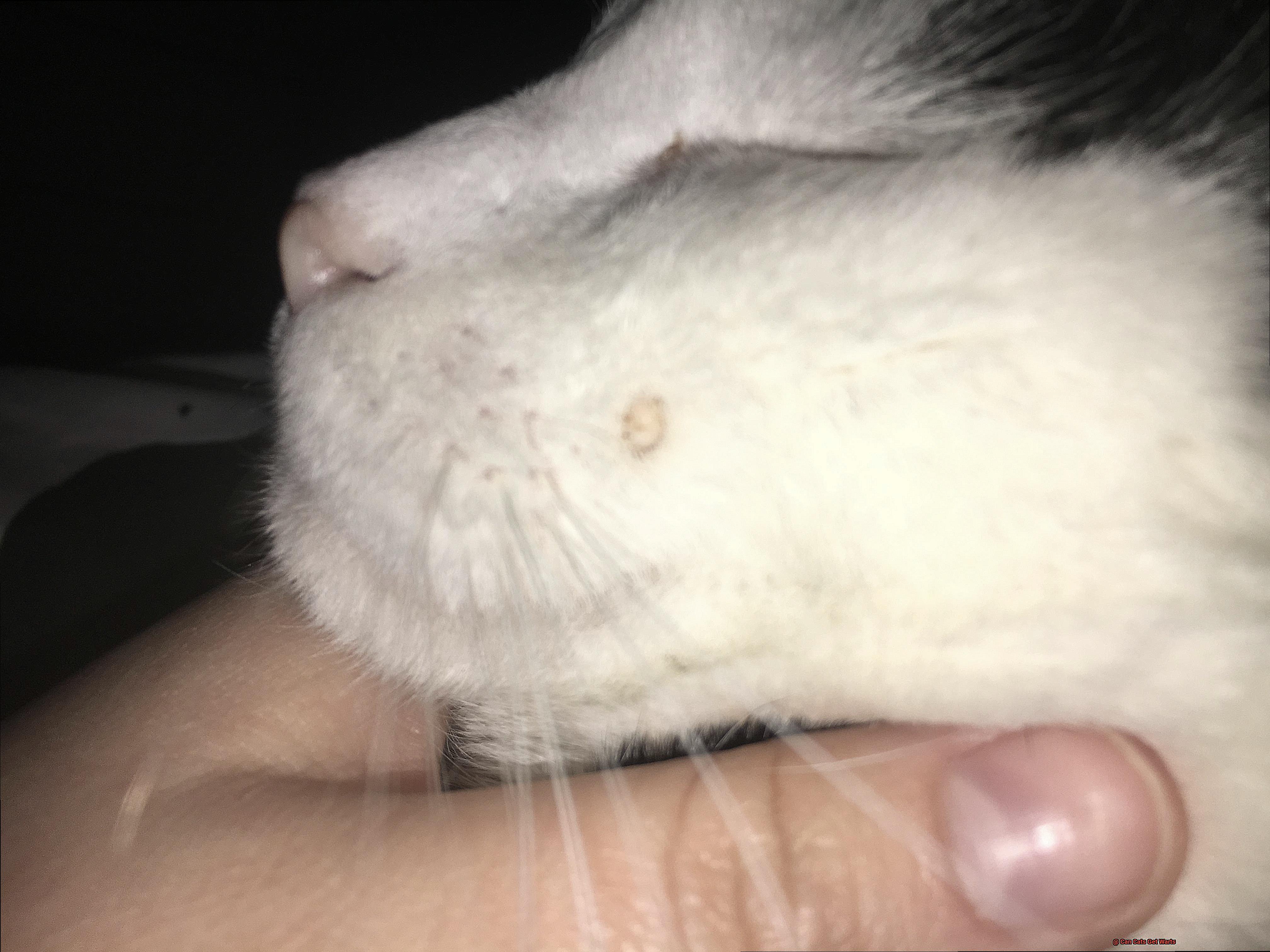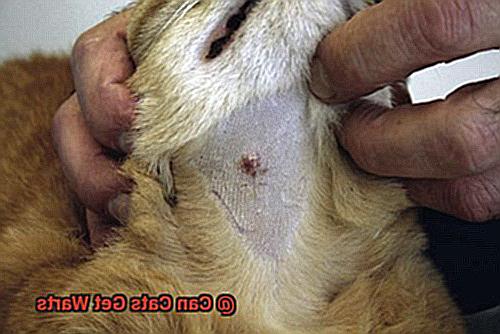Do you ever notice bumps on your cat’s skin and wonder if they’re warts?
It’s a common query among pet owners. The answer may surprise you: cats can get warts, just like humans.
Warts are caused by the papillomavirus, which cats can catch as easily as people can. Most cats won’t have warts, but certain breeds are more susceptible than others.
They usually appear on the face, neck, or paws. Although warts aren’t harmful to your cat’s health, they can be traumatic and unsightly.
So it’s important to understand how cats get warts and what to do if your cat has them. In this blog post, we’ll cover everything from how the virus is spread to how it’s treated.
We’ll also discuss ways to prevent your cat from catching it in the first place. So if you’ve ever wondered whether cats can get warts, read on.
We’ll give you all of the details you need to keep your feline friend healthy and wart-free.
What are Warts?
Warts are the result of infection with the human papillomavirus (HPV).
These benign growths appear as small bumps with a rough surface, and they can be black, brown, or pink depending on the skin color. Warts are most commonly found on the hands, feet, and face but can occur anywhere on the body.
There are several types of warts including common warts, plantar warts, flat warts, and genital warts. Kittens are more susceptible to warts due to their weaker immune systems.
Adult cats may also develop warts if they come into contact with the virus. Fortunately, in most cases, these growths will die on their own without intervention.
It is important to consult a healthcare professional before choosing a treatment option though, especially if the wart is in a sensitive area or if you have a weakened immune system. Although it is rare for cats to develop warts due to HPV not being present in felines, there are other viruses that can cause similar skin growths in cats.
If you notice any unusual growths on your cat’s skin it is important to have them examined by a veterinarian to determine the cause and appropriate treatment.
What Causes Warts in Cats?
Warts, the pesky and sometimes painful growths, can affect cats just as they do humans.
Although warts in cats are less common than in dogs, they can still occur. The virus that causes warts in cats is feline papillomavirus (FePV), which has several subtypes.

FePV can infect cats of all ages and breeds but is more likely to affect younger or immunocompromised cats. This virus is typically spread by direct contact with infected skin or indirectly through items such as grooming products, toys, or bedding.
FePV can cause two distinct types of warts: oral and cutaneous. Oral warts appear as small white bumps on the gums, tongue, throat, or palate of the cat and may cause pain, drooling, difficulty eating or drinking, or bad breath.
Cutaneous warts are flat or raised growths that can be found almost anywhere on the cat’s body and may be itchy and fade or change color over time. Apart from FePV, other viruses such as feline calicivirus, feline immunodeficiency virus, and feline leukaemia virus can also cause warts or wart-like lesions in cats.
To prevent warts in cats it is important to maintain good hygiene; provide a balanced diet and clean water; avoid unnecessary contact with other cats; vaccinate the cat against FePV if available; and seek veterinary assistance if any unusual bumps are found on your pet’s skin.
Symptoms of Warts in Cats
If you notice bumps on your cat’s body, it may be warts caused by the feline papillomavirus (FePV).
Although these warts are usually harmless and benign, they can still cause discomfort for your cat if they are located in areas where the cat frequently grooms itself, such as its mouth or ears. In some cases, warts can also appear on a cat’s paw pads and cause limping or lameness.
To ensure your cat is healthy and free of pain, it is important to take them to the veterinarian for a proper diagnosis. Your vet will examine the wart and determine if it is benign or if further tests are required.
Good hygiene, balanced diet, immunization, and prompt veterinary care are all essential for preventing and treating feline warts.
Diagnosis and Treatment of Warts in Cats
It could be warts caused by FePV, but don’t worry – they’re usually harmless.

However, if the warts are in difficult-to-reach places like the ears or throat, they may cause health issues; therefore, it’s important to bring your cat to the veterinarian for a proper diagnosis and treatment. Diagnosing warts in cats can be tricky as they look similar to other skin growths such as papillomas, melanomas, and skin tags.
A physical examination, biopsy of the skin lesion, or dermatoscope may be used to confirm the diagnosis. Once diagnosed, there are various treatments available based on the size, location, and number of warts present.

Surgical removal is a common option that involves excising the wart and surrounding tissue with local anesthesia. Cryotherapy is another method that uses liquid nitrogen to freeze and kill off the wart.
Electrocautery applies an electric current to remove the wart while laser surgery uses a high-intensity beam of light to burn it off. It’s important to consider potential risks and benefits of each treatment option before proceeding with therapy as some medications may cause scarring or discomfort for your cat.
Your veterinarian will be able to advise you which treatment strategy is right for your cat’s specific situation.
Prevention of Warts in Cats
Warts can be a real problem for cats, as they are caused by the papillomavirus which can be passed through skin contact, saliva, or other body fluids.
Fortunately, there are a few steps you can take to help keep your cat safe from warts. First and foremost, try to avoid contact with feral cats as they often carry the virus.
Similarly, limit your cat’s time in crowded spaces where it may come into contact with other cats who may have the virus. Additionally, maintain good hygiene practices; make sure litter boxes, bedding supplies, and feeding areas are regularly cleaned to reduce the risk of viral infections.
You should also focus on boosting your cat’s immune system with a healthy diet full of vitamins and minerals. Exercise is also important for strengthening the immune system and promoting overall health.
Grooming is equally important; it helps remove debris and promotes skin health. Dry or irritated skin is more prone to viral infections so make sure to keep moisture levels up and minimize exposure to harsh grooming products that strip away natural oils.
Finally, consider vaccinating your cat against some of the viruses that cause warts such as feline leukemia virus (FeLV). Vaccination can reduce the likelihood of your cat contracting such viruses but it isn’t a guarantee since some cats may still contract the virus despite being vaccinated.
Home Remedies for Treating Warts in Cats
Cats can be just as prone to warts as humans, and if you’ve noticed bumps on your feline friend’s skin, it could be warts.
While it’s always best to seek professional help for proper diagnosis and treatment, there are some home remedies that can help treat warts in cats.
Apple cider vinegar is a popular home remedy that can help dissolve the wart and prevent it from spreading.
- To apply, simply soak a clean cotton ball in diluted apple cider vinegar (one part vinegar and one part water) and gently dab the affected area twice daily until the wart disappears. Tea tree oil is another effective remedy that can dry out the wart and reduce infection.
- Using a cotton swab twice daily, you can apply one or two drops of tea tree oil directly to the wart; however, be careful not to use too much because tea tree oil can be toxic if ingested. Garlic is believed to have antiviral properties that can also aid in treating feline warts.
- Crush a clove of garlic and mix it with a small amount of coconut oil to make a paste, then apply it to the wart and cover with a small bandage once daily until the wart disappears. Aloe vera gel is another natural treatment that can soothe inflamed and irritated warts in cats.
- Simply apply a small amount of pure aloe vera gel to the wart using a cotton swab twice daily; however, it may not be as effective at treating larger warts.
How to Care for a Cat with Warts
Warts in Cats: Warts in cats are typically harmless and don’t require any special treatment. They are caused by the papillomavirus, which is spread through contact or body fluids, and can appear on the cat’s body in any manner. These warts often look like small, rough bumps with a rough surface that can be red, brown, or pink.
Monitoring Your Cat’s Warts
To ensure your cat’s comfort and well-being, it is important to keep an eye on their warts and monitor them for any changes in size, shape, or appearance. If you notice any changes or if your cat’s warts seem to be causing them discomfort, you should consult with your veterinarian for further information.
Treatment Options
In some cases, your veterinarian may recommend treating your cat’s warts with topical medications or by removing them surgically. However, these treatments are typically only necessary if the warts are causing significant problems for your cat.
A Clean Environment
To make your cat more comfortable while they have warts and prevent wart transmission, it is essential to keep their environment clean and sanitary by regularly cleaning and disinfecting their litter box, food and water dishes, and bedding.
Preventing Spread
In addition to treating your cat’s warts, it is also important to take steps to prevent them from spreading to other pets in your household. This means keeping infected cats away from other animals and disinfecting any surfaces or objects that come into contact with their warts. Your veterinarian may also recommend vaccinating other pets in your household against the virus that causes warts in cats.
When to See a Vet for Wart Treatment in Cats
If your cat has warts, it’s important to know when to seek veterinary help.
While some warts may resolve on their own, others can be more serious and require medical attention. If the wart is causing discomfort or interfering with your cat’s daily activities, this is an indication that you should consult a vet.
Warts can cause irritation or bleeding if scratched or bitten at, which can lead to infection. If the wart is located in an area where it is easily irritated, such as on the paw or around the mouth, it is essential to see a vet for treatment.
Additionally, if the wart appears to be growing rapidly or changing in appearance, this could signal a more serious issue and require medical attention. Though most warts are benign, some can become cancerous if left untreated.
By staying vigilant and seeking veterinary care when necessary, pet owners can ensure their furry friends remain healthy and happy.
Conclusion
Can cats get warts?
The answer is yes. Feline papillomavirus (FePV) is the virus that causes them.
Warts can appear anywhere on your cat’s body, but are most commonly found on their face, neck, and paws. Although they don’t pose a serious risk to your pet’s health, they can be painful and unsightly.
To prevent and treat warts in cats, it’s important to practice good sanitation; feed a balanced diet with clean water; avoid contact with other cats; vaccinate if available; and seek medical assistance for any unusual bumps. Additionally, you can apply apple cider vinegar, tea tree oil, garlic paste or aloe vera gel to reduce inflammation and pain associated with warts.
Finally, keep an eye out for any changes in size or appearance of the warts, and seek veterinary care as needed.







